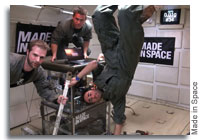Popular Press Exaggerates 3D-Printing Technology Says NRC Report
 National Research Council Report Says It’s Too Soon for 3-D Printing to Significantly Enhance Space Operations, SpaceRef Business
National Research Council Report Says It’s Too Soon for 3-D Printing to Significantly Enhance Space Operations, SpaceRef Business
“A National Research Council report, 3D Printing in Space, says it’s too soon for 3-D Printing to significantly enhance space operations. Released today, the report includes several recommendations including that NASA and the Air Force should jointly cooperate, possibly with other agencies and industry, “to to research, identify, develop, and gain consensus on standard qualification and certification methodologies for different applications.”
“Many of the claims made in the popular press about this technology have been exaggerated.” said Robert Latiff, chair of the committee that wrote the report, president of Latiff Associates, and a former Air Force Major General. “For in-space use, the technology may provide new capabilities, but it will serve as one more tool in the toolbox, not a magic solution to tough space operations and manufacturing problems. However, right now NASA and the Air Force have a tremendous resource in the form of the International Space Station,” Latiff added. “Perfecting this technology in space will require human interaction, and the Space Station already provides the infrastructure and the skilled personnel who can enable that to happen.”
Related: Too Soon for 3-D Printing to Significantly Enhance Space Operations, Report Says, National Research Council
Made In Space 3D Printer Gets Green Light from NASA for Launch, SpaceRef Business









Interesting comments. Isn’t the SpaceX SuperDraco motor essentially a 3D printed one? Seems fairly significant if it is.
Cheers
Perhaps he’s referring to much larger 3D printing concepts such as 3D printing shelters in situ on the Moon.
Doesn’t say that anywhere. Just refers to “in-space use” which could be anything from a bolt to a habitat.
Cheers
3D printing is moving too fast for current assessments by NRC to mean much for long. In areas moving that fast the pundits are usually 3-4 innovations behind reality. Been there, seen that.
The Draco thruster was 3D fab on Earth, not in space. And it may have needed some finish machining. The technology does seem hyped a bit, but it’s strange the NRC would be involved unless for some reason they were asked to evaluate it by NASA.
The SD is used in-space as opposed to manufactured in space and I’m sure does need some finishing and testing but EM stated that without the new technology of 3D printing, it would have been a much harder if not impossible task to get the motor designed and manufactured.
This statement “For in-space use, the technology may provide new capabilities, but it will serve as one more tool in the toolbox, not a magic solution to tough space operations and manufacturing problems.” just seems like a re-run of the “space is hard” and “space is expensive” ho hum that comes out of the old space industrial complex.
Anything innovative means it needs stifling quick smart else we won’t get the funding we used to and all those high paying jobs’ll disappear.
Cheers.
The energy requirements for 3d printing of metals in space are pretty high, along with the limitation that powder control would require some artificial gravity. 3D printing of plastics is much lower power and uses a coil of material, no gravity issue.
Nearly everyone has printed a 3d engine, NASA fired one last year. Rocketdyne fired one early this year, larger than a thruster, probably basis for second stage engine.
That’s great. What vehicle(s) are they planning on using them in, pray tell? SpaceX is planning on flying them in their Dragon V2 as their abort and/or vertical landing engine and their abort test milestone is later this year.
So there’s a big, big difference between just testing them as opposed to using one as a real piece of flying hardware.
Cheers
“However, right now NASA and the Air Force have a tremendous resource in the form of the International Space Station,” Latiff added.
This is intriguing. When has the AF been involved in the ISS and to what extent. Perhaps I’m missing something here but I was under the impression that the ISS was an international civilian facility with no links to any defence forces.
If the Russians get wind of this they’ll embargo the station pronto. LOL.
Cheers.
The MSSE missions (I think they are up to twelve now), take USAF materials payloads up all the time and everyone knows about it.
Thanks for that info’. Guess I’m not ‘everyone!
Cheers
So how come NASA is spending millions on additive manufacturing in space,where nobody needs it, and not a penny on developing standards for its use in AVIATION and other demanding tech applications, where it could maybe win back a few actual commercial jobs from China?????
It’snot just the press that’s exaggerating. I was a little skeptical of this report until I found this paragraph. Floored me. Worth every penny. Too bad NASA will not read it.
=========================================================
The committee has also identified a number of obstacles to achieving these desired outcomes, including a lack of clarity on mission scenarios that would drive the development of appropriate additive manufacturing technologies toward addressing real NASA and Air Force challenges, obsession with a new and novel technology without a clear eye toward potential costs, and lack of understanding of technical limitations and performance criteria.
========================================================
it’s not NASA’s job to develop standards.
additive manufacturing could be fantastic for use in space. rather than needing an expensive launch to send up a replacement part for something, you just make your own.
It depends on the type of component and the type of failure. If the part is designed to be replaced only as part of an LRU, it may be more practical to bring a spare LRU to install if there is a failure and transport a new spare to the station with the next logistics flight. If the component which has failed is inaccessible (i.e. a valve seat) or electronic, or too large to print, or a leak in a window seal, or a bent airlock hinge, it may not be enough. Basically you need a machine shop and an electronics shop. You’ll find this type of onboard maintenance capability on large ships such as carriers, but not on a boat with a crew of only six (i.e. the ISS). As the report says, 3D printing is a tool, not a cure-all. We can’t even decide whether to use metric or “English” units. That’s how far behind the curve we are.
“It depends on the type of component and the type of failure.”
obviously.
I’m just making the point that it’s not a cure-all for the high cost of access to space. Somewhere it may exist, but I haven’t seen any documentation of actual failures in space that could only be repaired by 3-D printing.
huh. do you have no imagination at all? 3D printing has great potential.
The only world Vulture knows is Space-X…….he lives in a Space-X centered box……
A good article on 3D printing
http://www.spacenews.com/ar…
I Hope that people aren’t under the impression that 3D printing is a magic solution for all scenarios- the technology is still very much in it’s infancy.
However, the testing that has been accomplished so far has shown that it does have beneficial utility. It needs to be explored more, and funded appropriately.
Why should it be funded at all? Funded by who and to what end. Is it not starting to be used by Industry already? Won’t industry improve it to make better stuff?
Well, an example of the research being conducted on the potential of 3D printing on space mission is happening during the Hawaii- Space Exploration and Analog Simulation (HI-SEAS). A rudimentary 3D printer (funded by NASA’s Human Research Program) is being tested on its utility to produce basic tools on demand. The crew has used it construct simple devices as the need has arisen. I believe this is a positive way to fund and test 3D printing.
It does not need federal funding. Out in the real world it is coming along nicely
http://www.asiawebinar.com/…
The main issue I see with 3D printing problems is quality control, and under various different environments. Case in point, ask any dentist about the quality of 3D printed crowns as most will claim them to be of inferior structural integrity.